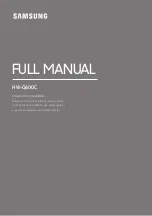
Page 4 of 12
6. The unit is supplied with a ten-position, pluggable connector (color green) for the other connections. Insert the wire into the connector and
tighten the screw at these appropriate connector positions:
a. Speaker – the siren is designed to operate with one 11-ohm impedance speaker (100W) or two 11-ohm impedance speakers (200W).
Speakers are not included as part of the siren. Any 11-ohm 100W speakers for use with emergency vehicle may be considered to use.
When using two speakers, they must be connected in parallel and in phase.
WARNING!
CONNECTION OF A 58 WATT SPEAKER TO THE SPKR TERMINAL WILL CAUSE THE SPEAKER TO BURN OUT, AND WILL VOID THE
SPEAKER WARRANTY!
b. Horn Ring In and Out – The horn ring transfer circuit is capable of switching a maximum of 10 amperes. An external relay is not required
for horn ring operation. Locate the wire that connects the vehicle horn ring switch to the horn or horn relay. Cut this wire. Connect a wire
from “HORN RING IN” position on the connector to the horn ring side of the wire that was just cut. Connect a wire from “HORN RING
OUT” position on the connector to the horn side of the cut wire. Properly insulate the wires. (Note: A footswitch may be substituted to
use with “HORN-TAP” function. Connect a wire to one end of the footswitch wire to the other end of the footswitch wires and the vehicle
chassis.). The user has the option for two different tone outputs when depressing the horn – Air Horn (default) or Manual. See the
section titled “Operation” for dip switch configurations.
c. Chassis ground – This wire should not be left unconnected. It is necessary to connect the siren enclosure to ground and gain shielding
effect. Use an 18-gause wire to connect the siren case to a good vehicle chassis point.
d. Door/Park-Siren-Off input – This feature automatically deactivates siren tones when the vehicle is shifted into PARK. Lighting Level 3
will also “drop-out “ if this feature is enabled via the front panel dip switch. Siren tones will be disabled until the vehicle is shifted out of
PARK. This circuit is activated by a negative signal. Connect this input to a circuit that is GROUNDED when the vehicle is shifted into
PARK. It is the installer’s responsibility to determine an appropriate location in the vehicle circuitry to connect this wire. See the section
titled “Operation” for dip switch configurations.
e. Radio rebroadcast - Any line output signal with nominal one volt peak to peak can be connected here. If the output seems to start dis-
torted, reduce the radio gain by adjusting the “Radio Gain” trimmer on front of siren amplifier.
7. Plug the ten-position connector into the mating connector on the unit, and apply pressure until it locks into place.
8. To install the lightbar power wires, strip approximately 1/4″ of insulation from the end of the lights wires. Insert the wire in the appropriate
terminal of 7-position screw terminal block and tighten the screw. Keep in mind that terminals LEV1, LEV2, and LEV3 have a 20 amp
maximum current each, and terminals AUX1, AUX2, AUX3, and AUX4 have a 10 amp maximum current each. The total current of all 7
terminals is limited to 60 Amps,
9. Both +12VLTG terminals should be connected directly to a 12V source. This connector provides power to the 3 Level, progressive lighting
outputs and the 4 auxiliary outputs. This connection is designed to provide 60 amp service and therefore nothing smaller than #4 gauge
wire should be connected to it. If a fuse is installed, it should be sized for the actual load of the lighting used and located as close to the
battery positive as possible.
10. Ensure that there are no loose wire strands or other bare wire that may cause a short circuit. All wires must be protected from any sharp
edged that could eventually cut through the insulation. Also use an ohmmeter to verify that a short circuit does not exist between the posi-
tive (+) leads and the vehicles chassis.
11. Perform visual check of all connections and wiring more before connecting the red wire to the positive (+) terminal and black wire to the
negative (-) terminal of the battery.
Содержание H2 Covert
Страница 9: ...Page 9 of 12 Figure 3 ...






























